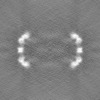+ Open data
Open data
- Basic information
Basic information
| Entry |  | |||||||||
|---|---|---|---|---|---|---|---|---|---|---|
| Title | Streptococcus agalactiae GOLLD RNA 3' domain dodecamer | |||||||||
 Map data Map data | ||||||||||
 Sample Sample |
| |||||||||
 Keywords Keywords | ncRNA / RNA | |||||||||
| Biological species |  Streptococcus agalactiae (bacteria) Streptococcus agalactiae (bacteria) | |||||||||
| Method | single particle reconstruction / cryo EM / Resolution: 6.61 Å | |||||||||
 Authors Authors | Peng X / Wang L / Su Z | |||||||||
| Funding support |  China, 1 items China, 1 items
| |||||||||
 Citation Citation |  Journal: Science / Year: 2025 Journal: Science / Year: 2025Title: Cryo-EM reveals mechanisms of natural RNA multivalency. Authors: Liu Wang / Jiahao Xie / Tao Gong / Hao Wu / Yifan Tu / Xin Peng / Sitong Shang / Xinyu Jia / Haiyun Ma / Jian Zou / Sheng Xu / Xin Zheng / Dong Zhang / Yang Liu / Chong Zhang / Yongbo Luo / ...Authors: Liu Wang / Jiahao Xie / Tao Gong / Hao Wu / Yifan Tu / Xin Peng / Sitong Shang / Xinyu Jia / Haiyun Ma / Jian Zou / Sheng Xu / Xin Zheng / Dong Zhang / Yang Liu / Chong Zhang / Yongbo Luo / Zirui Huang / Bin Shao / Binwu Ying / Yu Cheng / Yingqiang Guo / Ying Lai / Dingming Huang / Jianquan Liu / Yuquan Wei / Siqi Sun / Xuedong Zhou / Zhaoming Su /  Abstract: Homo-oligomerization of biological macromolecules leads to functional assemblies that are critical to understanding various cellular processes. However, RNA quaternary structures have rarely been ...Homo-oligomerization of biological macromolecules leads to functional assemblies that are critical to understanding various cellular processes. However, RNA quaternary structures have rarely been reported. Comparative genomics analysis has identified RNA families containing hundreds of sequences that adopt conserved secondary structures and likely fold into complex three-dimensional structures. In this study, we used cryo-electron microscopy (cryo-EM) to determine structures from four RNA families, including ARRPOF and OLE forming dimers and ROOL and GOLLD forming hexameric, octameric, and dodecameric nanostructures, at 2.6- to 4.6-angstrom resolutions. These homo-oligomeric assemblies reveal a plethora of structural motifs that contribute to RNA multivalency, including kissing-loop, palindromic base-pairing, A-stacking, metal ion coordination, pseudoknot, and minor-groove interactions. These results provide the molecular basis of intermolecular interactions driving RNA multivalency with potential functional relevance. | |||||||||
| History |
|
- Structure visualization
Structure visualization
| Supplemental images |
|---|
- Downloads & links
Downloads & links
-EMDB archive
| Map data |  emd_62724.map.gz emd_62724.map.gz | 22.5 MB |  EMDB map data format EMDB map data format | |
|---|---|---|---|---|
| Header (meta data) |  emd-62724-v30.xml emd-62724-v30.xml emd-62724.xml emd-62724.xml | 14.6 KB 14.6 KB | Display Display |  EMDB header EMDB header |
| FSC (resolution estimation) |  emd_62724_fsc.xml emd_62724_fsc.xml | 13.8 KB | Display |  FSC data file FSC data file |
| Images |  emd_62724.png emd_62724.png | 81.7 KB | ||
| Filedesc metadata |  emd-62724.cif.gz emd-62724.cif.gz | 4.2 KB | ||
| Others |  emd_62724_half_map_1.map.gz emd_62724_half_map_1.map.gz emd_62724_half_map_2.map.gz emd_62724_half_map_2.map.gz | 254.3 MB 254.3 MB | ||
| Archive directory |  http://ftp.pdbj.org/pub/emdb/structures/EMD-62724 http://ftp.pdbj.org/pub/emdb/structures/EMD-62724 ftp://ftp.pdbj.org/pub/emdb/structures/EMD-62724 ftp://ftp.pdbj.org/pub/emdb/structures/EMD-62724 | HTTPS FTP |
-Validation report
| Summary document |  emd_62724_validation.pdf.gz emd_62724_validation.pdf.gz | 954.6 KB | Display |  EMDB validaton report EMDB validaton report |
|---|---|---|---|---|
| Full document |  emd_62724_full_validation.pdf.gz emd_62724_full_validation.pdf.gz | 954.2 KB | Display | |
| Data in XML |  emd_62724_validation.xml.gz emd_62724_validation.xml.gz | 23 KB | Display | |
| Data in CIF |  emd_62724_validation.cif.gz emd_62724_validation.cif.gz | 30 KB | Display | |
| Arichive directory |  https://ftp.pdbj.org/pub/emdb/validation_reports/EMD-62724 https://ftp.pdbj.org/pub/emdb/validation_reports/EMD-62724 ftp://ftp.pdbj.org/pub/emdb/validation_reports/EMD-62724 ftp://ftp.pdbj.org/pub/emdb/validation_reports/EMD-62724 | HTTPS FTP |
-Related structure data
- Links
Links
| EMDB pages |  EMDB (EBI/PDBe) / EMDB (EBI/PDBe) /  EMDataResource EMDataResource |
|---|
- Map
Map
| File |  Download / File: emd_62724.map.gz / Format: CCP4 / Size: 274.6 MB / Type: IMAGE STORED AS FLOATING POINT NUMBER (4 BYTES) Download / File: emd_62724.map.gz / Format: CCP4 / Size: 274.6 MB / Type: IMAGE STORED AS FLOATING POINT NUMBER (4 BYTES) | ||||||||||||||||||||||||||||||||||||
|---|---|---|---|---|---|---|---|---|---|---|---|---|---|---|---|---|---|---|---|---|---|---|---|---|---|---|---|---|---|---|---|---|---|---|---|---|---|
| Projections & slices | Image control
Images are generated by Spider. | ||||||||||||||||||||||||||||||||||||
| Voxel size | X=Y=Z: 1.1 Å | ||||||||||||||||||||||||||||||||||||
| Density |
| ||||||||||||||||||||||||||||||||||||
| Symmetry | Space group: 1 | ||||||||||||||||||||||||||||||||||||
| Details | EMDB XML:
|
-Supplemental data
-Half map: #1
| File | emd_62724_half_map_1.map | ||||||||||||
|---|---|---|---|---|---|---|---|---|---|---|---|---|---|
| Projections & Slices |
| ||||||||||||
| Density Histograms |
-Half map: #2
| File | emd_62724_half_map_2.map | ||||||||||||
|---|---|---|---|---|---|---|---|---|---|---|---|---|---|
| Projections & Slices |
| ||||||||||||
| Density Histograms |
- Sample components
Sample components
-Entire : Streptococcus agalactiae GOLLD RNA 3' domain dodecamer
| Entire | Name: Streptococcus agalactiae GOLLD RNA 3' domain dodecamer |
|---|---|
| Components |
|
-Supramolecule #1: Streptococcus agalactiae GOLLD RNA 3' domain dodecamer
| Supramolecule | Name: Streptococcus agalactiae GOLLD RNA 3' domain dodecamer type: complex / ID: 1 / Parent: 0 |
|---|---|
| Source (natural) | Organism:  Streptococcus agalactiae (bacteria) Streptococcus agalactiae (bacteria) |
-Experimental details
-Structure determination
| Method | cryo EM |
|---|---|
 Processing Processing | single particle reconstruction |
| Aggregation state | particle |
- Sample preparation
Sample preparation
| Buffer | pH: 7.5 |
|---|---|
| Vitrification | Cryogen name: ETHANE |
- Electron microscopy
Electron microscopy
| Microscope | TFS KRIOS |
|---|---|
| Image recording | Film or detector model: GATAN K2 QUANTUM (4k x 4k) / Average electron dose: 48.0 e/Å2 |
| Electron beam | Acceleration voltage: 300 kV / Electron source:  FIELD EMISSION GUN FIELD EMISSION GUN |
| Electron optics | Illumination mode: FLOOD BEAM / Imaging mode: BRIGHT FIELD / Nominal defocus max: 1.5 µm / Nominal defocus min: 0.8 µm |
| Experimental equipment |  Model: Titan Krios / Image courtesy: FEI Company |
 Movie
Movie Controller
Controller














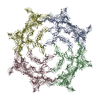
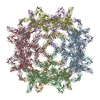
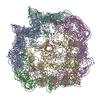
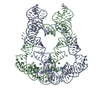
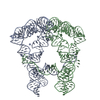
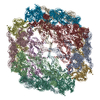

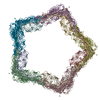
 Z (Sec.)
Z (Sec.) Y (Row.)
Y (Row.) X (Col.)
X (Col.)
























